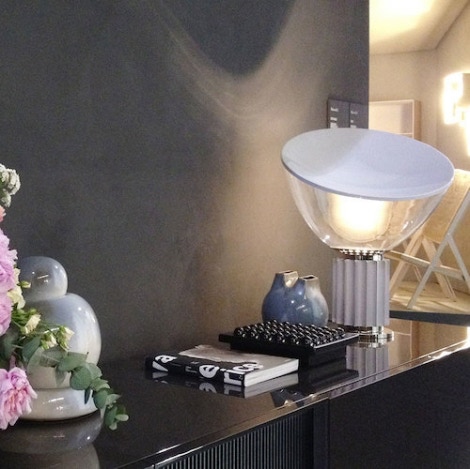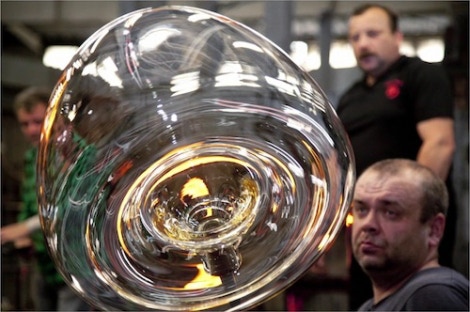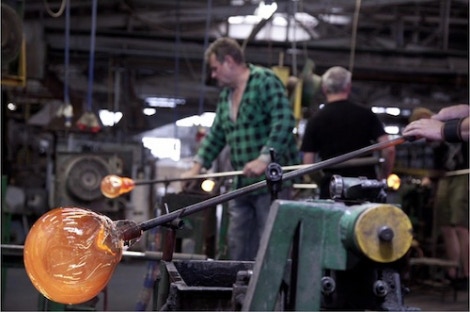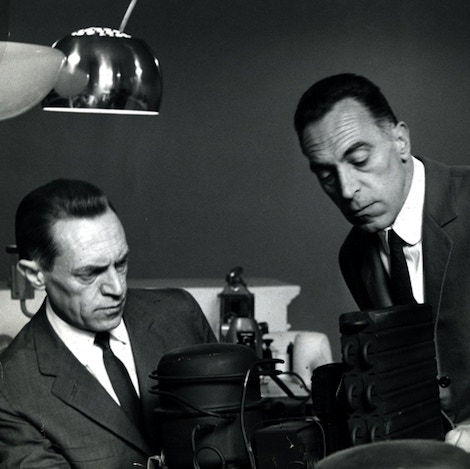
The Taccia lamp was created by the Italian designers Achille and Pier Giacomo Castiglioni in 1962. It combines very refined materials, such as the blown glass used for its bowl-shaped diffuser – the glass comes from Murano, an Italian island located in the lagoon of Venice and renowned for its long tradition of glassware – and more industrial elements, such as its extruded aluminum body, whose shape is reminiscent of a stylized gear. The result is an astonishing lamp, both classic and modern. Timeless.
Today, the light bulb inside the base has been replaced by a built-in LED board to keep up with technological developments in lighting. This board emits a rather warm light (2700K). It goes through the glass bowl, towards a concave reflector in painted aluminum, glossy white on the outside, and matt white on the inside. The light is redirected largely downwards, providing indirect and non-glare lighting. The Taccia lamp has an electric cord equipped with a dimmable ON / OFF switch, allowing to adjust the light intensity from 10 to 100%.
The bowl, simply placed on the base, can be positioned freely with a simple gesture of the hand. It allows to direct the light according to your needs. The Taccia lamp can be used as a table lamp, but it can also be placed on the floor, like a stage projector.
In 2016, Flos launched a smaller version of the lamp – the Taccia Small – to meet a demand for lighting up smaller spaces. A new version of the classic lamp was also released: the bowl, originally made of blown glass, is now available in PMMA, a polymer that is also called acrylic glass. It is transparent, very strong (not to say indestructible), lighter and much more affordable than glass. This material is much closer to the one originally chosen by the Castiglioni brothers, before they had to turn to glass for heat resistance: an LED board, unlike a conventional light bulb, does not not heat, or very little.
Warranty 2 years
Dimensions H48,5 x Ø37,3 cm – cord 190 cm
Light source LED integrated, 2700K (warm light), dimmer 10-100%
Materials nickel-plated ABS and polycarbonate base, extruded aluminum body, painted aluminium reflector, transparent blown glass diffuser
Taccia Small – Matt Black
Taccia Small – Silver Anodized
Taccia Small – Bronze Anodized
Taccia Small – Matt White
Dimensions H64,5 x Ø49,5 cm – cord 220 cm
Light source LED integrated, 2700K (warm light), dimmer 10-100%
Materials nickel-plated metal base, extruded aluminum body, painted aluminium reflector, transparent PMMA (acrylic glass) or blown glass diffuser
Taccia PMMA – Matt black
Taccia PMMA – Silver Anodized
Taccia Glass – Matt black
Taccia Glass – Silver Anodized
Taccia PMMA – Bronze Anodized
Taccia Glass – Matt white
Taccia Glass – Bronze Anodized




Achille Castigliono, about the Taccia lamp
The story around this lamp is rather interesting. It is interesting because someone mistakes it for a post-modern object. This is very funny because this lamp is from 1962 and we had, me and my brother, no intention of making a post-modern lamp.
I have to admit that this lamp has been conceived in the wrong way, it’s funny to say. It had plastic transparent materials that were needed to make this bowl. So we tested the object, and we had a very nice surprise. The plastic material, when heated, it flattened. So our object was conceived completely wrong. So we have tried it in glass.
And you see that column-shaped, well let’s say it’s a casing. That cools down that kind of cooker, the base. At the base of the object the heat is so intense that increasing the surface volume means cooling it down, like an engine, like the motor fins of an engine."

Manufacturing process
The glass bowl is made in Murano, Venice, and the process is time taking and meticulous.
First the sand goes into a refractory brick oven becoming an incandescent magma like « honey » at 1000/1600°C. Through a 2.5 meters long stainless steel pipe, expert craftsmen blow this « honey » into an underground mould, the very same one from the sixties. Detached with water from the pipe, the bowl is later deposited into a « Muffola » oven for 24 hours, slowly reaching ambient temperature.
The bowl is later sent to be manually cut, obtaining the final shape of the bowl. A handmade unique glass bowl, with outstanding transparency, dimension and quality features.






Achille & Pier Giacomo Castiglioni

Italian architects and designers Achille Castiglioni (1918-2002) and Pier Giacomo Castiglioni (1913-1968) are among the greatest names in modern Italian design. Their father was a notable architect, Giannino Castiglioni, and their brother, Livio Castiglioni, also became an architect and designer. Achille and Pier Giacomo both studied architecture at Politecnico di Milano and then worked there as teachers. Their collaboration has been productive and innovative, and the designs are often radical and humorous.
Similar to the designers of the first half of the 20th century, the Castiglioni brothers derive the beauty of an object from its function. Purity of lines, simple components, quality of materials, aesthetics intervenes to support the function.
Price Guarantee
Offering design at the right price is an integral part of our work. If you find the same item at a lower price at another retailer, delivery included, we will not only match it, but even offer you a better price.
How to take advantage of it?
We compare our prices every day with all authorized retailers in Europe. If nevertheless you find cheaper, contact us for a counter-proposal.
We must be able to verify that the item is authentic, new, perfectly identical (size, materials, color, etc.)
and that it is not part of a campaign or temporary destocking.
The valid basis is, for example, a current quote or a direct link to another retailer's website where the lower price is indicated. An email image is invalid, the original email must be forwarded.
The offer does not apply to orders already placed and cannot be combined with any of our other offers or promotions.